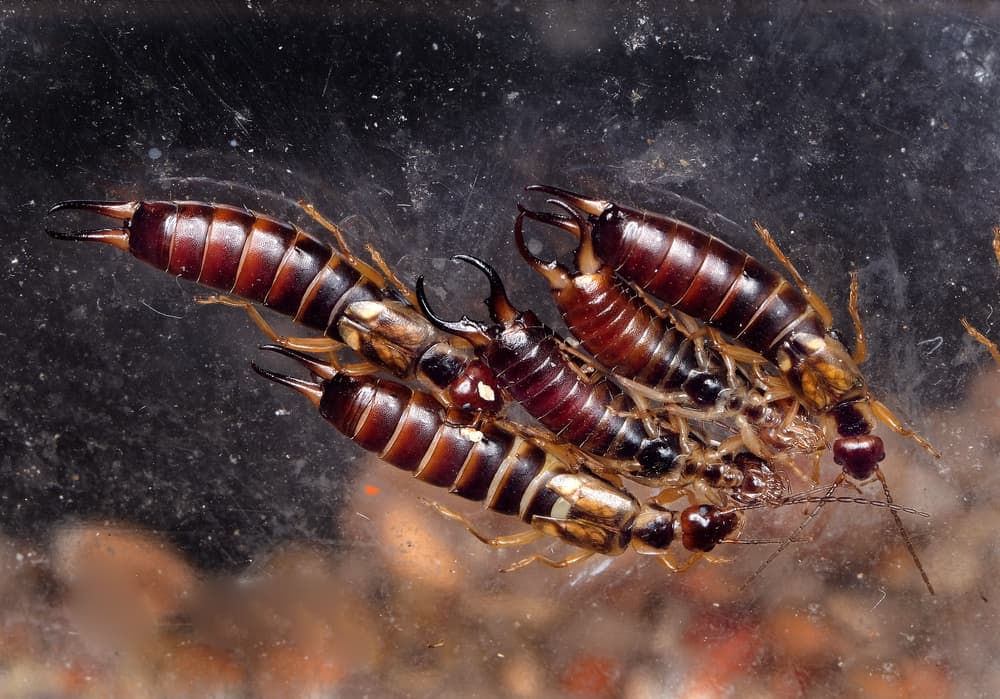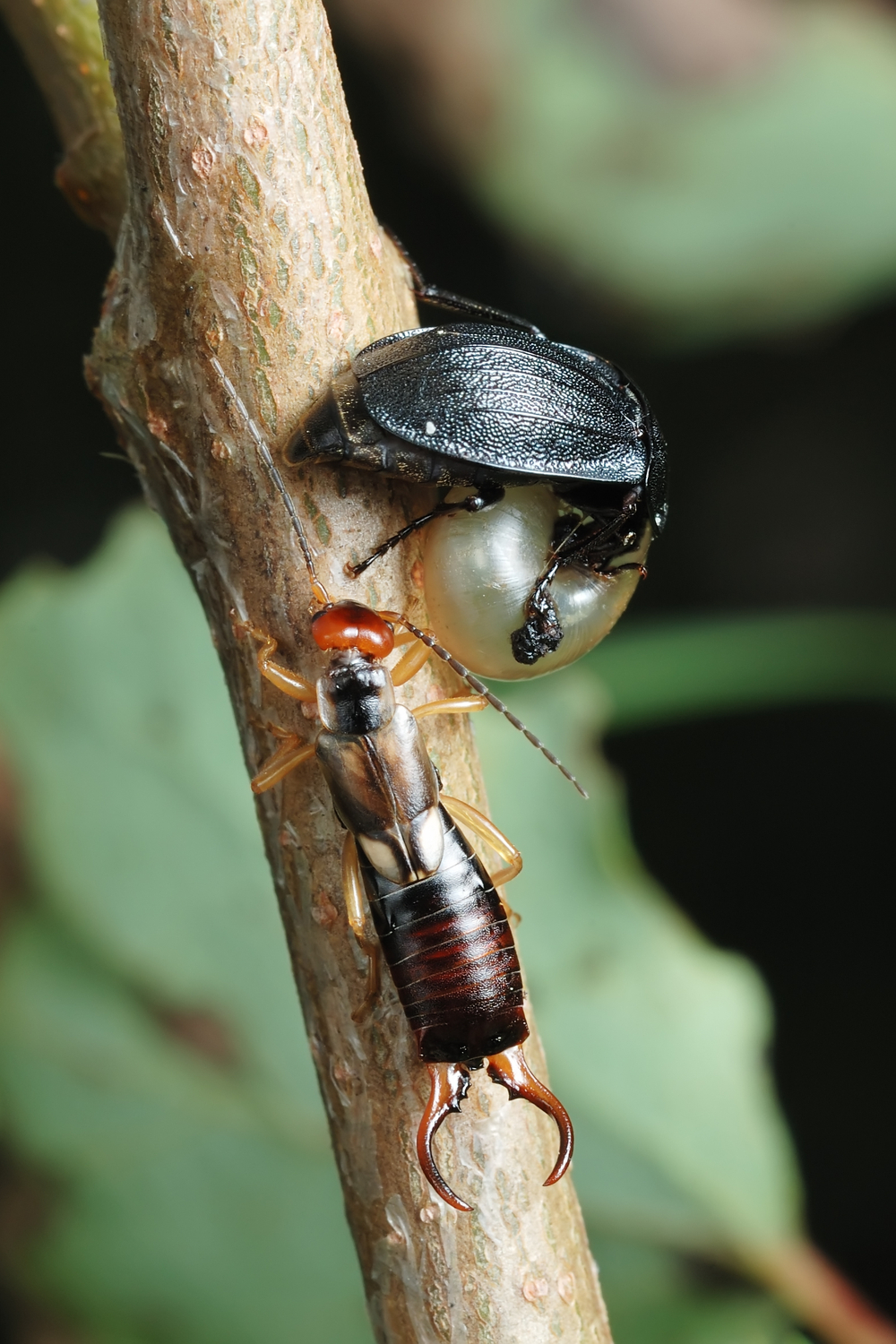Earwigs are intriguing little critters – but just how much do you know about them? What do earwigs eat? Where do they live? And are they pests or not?
That’s what we’re here to find out! We’re going to separate the facts about earwigs from the fiction. And we’ll learn more about the diet and behavior of these much-misunderstood insects.
So if you’re ready, step this way to find out more!
Earwig Habits and Biology
Earwigs are actually a whole order of insects, with the name Dermaptera. There are more than 2,000 different species, and they can be found throughout the Americas, Europe and Asia.
They usually have long, flat bodies, enabling them to fit into tight nooks and crannies. Most species are fairly small, with the littlest just over a quarter of an inch long.
One of the characteristic features of the earwig is its pincers. These are attached to the insect’s abdomen. The shape of the pincers is one way to tell male and female earwigs apart. The pincers of males have a more pronounced curve.
Those pincers are used in a variety of ways. They may hold prey as the earwig is eating. They’re sometimes used in fights between males. And some species also use them when “having relations”! You can find more about their pincers in this YouTube video from Deep Look.
The majority of earwigs have two pairs of wings, though a couple of species are wingless. But although most can fly, they do so only rarely.
Earwigs usually live for around a year. During this time they molt, losing their skin and growing a new one. This happens between 4 and 6 times over their lives. They mate during the Fall, and you can find male and female earwigs together over Fall and winter.
Most species are nocturnal. You’ll usually find them living in small piles of organic debris, fallen wood or bark. Some Hawaiian and South African earwigs, though, have been found living in caves.
They will occasionally enter homes, where you’ll most commonly find them on walls and ceilings. They don’t cause any damage, however, and can simply be removed and put back outside.
What Do Earwigs Eat in the Wild?
Earwigs are a mixed blessing in the garden. They eat other insects that are pests. But they also eat some kinds of plants themselves. The damage is, however, usually fairly mild, with young leaves and flowers most at risk. You may see small holes in those, but they won’t kill the plants.
Earwigs like to stay in cool, damp places, so any vegetation in a shady part of the garden will be a potential source of food. They’re not picky!
They also feed on smaller invertebrates, and sometimes use their pincers to hold their prey. Baby earwigs, known as nymphs, will even try to crack earwig eggs and eat their siblings! You can see them trying to do just that in this YouTube video from the Smithsonian Channel.
Let’s take a look in more detail at what earwigs eat:
- Decaying organic matter – earwigs help break down organic matter in the garden by eating a variety of decaying scraps. Tasty treats include composting leaves, grass and vegetables, and damp mulch. The insects feed on the carbon and other nutrients in the dying vegetation.
- Dead insects and carrion – earwigs aren’t fussy when it comes to dead animals! They’ll happily dine on other dead insects, or even the carcasses of larger animals. All these provide plenty of protein for the earwig.
- Small insects – as long as the insects are small enough, earwigs will eat them when they’re alive.
Tiny critters that fit into this category include aphids, which are far more of a garden pest than earwigs. Gardeners would do well to consider putting up with the minor damage of nibbled leaves to benefit from earwigs’ aphid-munching ways!
Other small bugs that feature on an earwig’s menu include mites, maggots, beetle larvae and even small spiders.
- Pest plants – earwigs are also a natural way to get rid of other unwanted garden inhabitants. They’ll eat moss, fungi and algae.
- Seedlings and tender plants – unfortunately, earwigs can cause damage to the plants we want in our garden too. Dahlias, clematis and chrysanthemums are particular targets. The earwigs will appear after dark and munch away, with young leaves and flowers their favorite snack.
- Fruits and vegetables – earwigs like fruit and veg too, and they’ll chow down on a wide range of different types. Earwig veggie treats include radishes, chard, cabbages and potatoes, while top fruits include apricots, peaches and plums.
Facts About Earwigs
1. They get their name from a myth
The name earwig comes from the belief that these insects crawled inside people’s ears. It didn’t stop there. They were believed to lay their eggs in people’s brains!
Happily, the egg laying part of this is completely untrue. And while earwigs might occasionally crawl into an ear, that’s only because it’s a dark space. Earwigs are far happier out of doors, and only find their way inside our homes by mistake.
2. Female earwigs are excellent mothers …
Female earwigs are very unusual amongst insects, in that they take excellent care of their young. After laying her eggs, the mother will stay with them constantly until they hatch. This can take several weeks.
During this time, she will carefully remove any mold that develops on the eggs to keep them healthy. Her grooming also applies an anti-fungal coating to the eggs, to help prevent more mold developing.
This care continues after the eggs hatch. In most species, the mother will continue to look after her young, bringing them food. The family will stay together until the baby earwigs – or nymphs – have shed their skins twice.
3. … But her children aren’t always grateful
“How sharper than a serpent’s tooth it is/ to have a thankless child!” cried Shakespeare’s King Lear. And few know the literal truth of this better than the mother hump earwig.
In this species, the young earwigs have a very special final stage of preparation to leave the nest. After weeks of being cared for by their mother, they eat her.
The practice is known as matriphagy, and some other insects do it too. Mom pays the ultimate sacrifice by providing a final, rich source of nutrition. And even better for the young earwigs, they don’t have to endanger themselves by leaving the nest to enjoy it.
4. Male earwigs are very well endowed
Gentlemen earwigs are endowed with large genitalia, known as virga. This can be as long as the rest of the male’s body in some earwig species. That makes it considerably longer than the female’s body.
What purpose, then, does this exuberant appendage serve? Well, some naturalists believe that the virga removes the sperm of other mates before inseminating the female.
5. Earwigs’ pincers are called cerci
The official name for earwigs’ distinctive pincers is cerci, although they are also known as forceps. While they look fearsome, they won’t do humans any damage.
It’s a different matter, though, when it comes to other earwigs. The cerci are used in combat between males.
But those males are lovers, as well as fighters. When courting a female, they will use their cerci to stroke the female on the abdomen. She in turn will nibble it. This is apparently part of the process for deciding whether she will accept him as a mate.
6. Some earwigs are rather smelly
Although earwigs won’t do any damage to your home, they can create an unpleasant odor. If they feel threatened, some species will emit a foul smelling liquid. And once there, the smell can be very difficult to get rid of.
7. They’re not great for wine
If harvested along with grapes, earwigs can impart a none-too-pleasing flavor to wine. Perhaps it’s the earwigs’ final revenge!
Believe it or not, specific research has been done into the effects of earwigs on wine flavor. Research found that the odd earwig didn’t make too much difference. But if ten or more earwigs were harvested per kilogram of grapes, they had a significant effect on the taste.
The culprit appeared to be the earwig poop, more than the earwigs themselves. Less than half a gram of this per kilo of grapes produced an unpleasant off flavor, variously described as “bitter”, “acidic” and “animal”. Nice!
8. There was once a 3-inch long earwig
Sadly, the giant earwig, also known as the St. Helena earwig, is now thought to be extinct. No examples of the species have been found since 1967.
Before that, however, it held the record for the largest earwig, measuring a mighty 3 inches long. Today, that record sits with the Australian giant earwig. This is a full inch shorter – though that’s still quite big enough in our book.
Summary
We hope you’ve enjoyed our look at earwigs! These insects sometimes get a bad press, but they’re truly amazing creatures.
Yes, they occasionally nibble on ornamental flowers, fruit and veg. But they do much less damage than the aphids they eat. On that basis, they could even be considered a gardener’s friend!
And remember, every earwig you see was once lovingly tended by its mother. Bless its little pincers!

